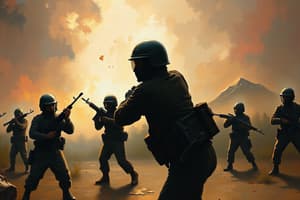Podcast
Questions and Answers
What is a defining characteristic of a farce?
What is a defining characteristic of a farce?
- Focus on real historical events
- Use of dramatic history
- Involvement of deception or miscommunication (correct)
- Emphasis on poetic lines and structure
Which element is NOT typically associated with farce?
Which element is NOT typically associated with farce?
- Absurd situations
- Manipulation of historical facts (correct)
- Physical comedy
- Slapstick humor
What is the primary purpose of dramatic history?
What is the primary purpose of dramatic history?
- To entertain with absurdity
- To adapt real events into a narrative (correct)
- To express emotions through visual art
- To provide an accurate portrayal of events
In what way does an outline in concrete poetry differ from a drawing?
In what way does an outline in concrete poetry differ from a drawing?
What characteristic makes the lines in concrete poetry distinct compared to traditional outlines?
What characteristic makes the lines in concrete poetry distinct compared to traditional outlines?
Flashcards are hidden until you start studying
Study Notes
Farce
- Defined as a comedy characterized by absurdity and exaggerated situations.
- Central elements include deception and miscommunication among characters.
- Commonly incorporates slapstick humor and physical comedy for comedic effect.
Dramatic History
- Based on real events, intertwines actual history with fictional elements.
- Utilizes literary devices to fill gaps in historical records, enhancing storytelling.
- Adapts historical figures into characters, providing interpreted perspectives.
- Aims to convey lessons or themes related to the events depicted.
Concrete Poetry
- Features a unique outline that emphasizes significant words associated with the poem's subject.
- Generally presented in a solid shape without spacing, creating a visual impact.
- Distinct from an outline, as it uses poetic lines with meaning to represent and form a visual of the subject.
- Lines in concrete poetry resemble sentences, often incorporating rhyme to add depth and shape to the artwork.
Studying That Suits You
Use AI to generate personalized quizzes and flashcards to suit your learning preferences.




